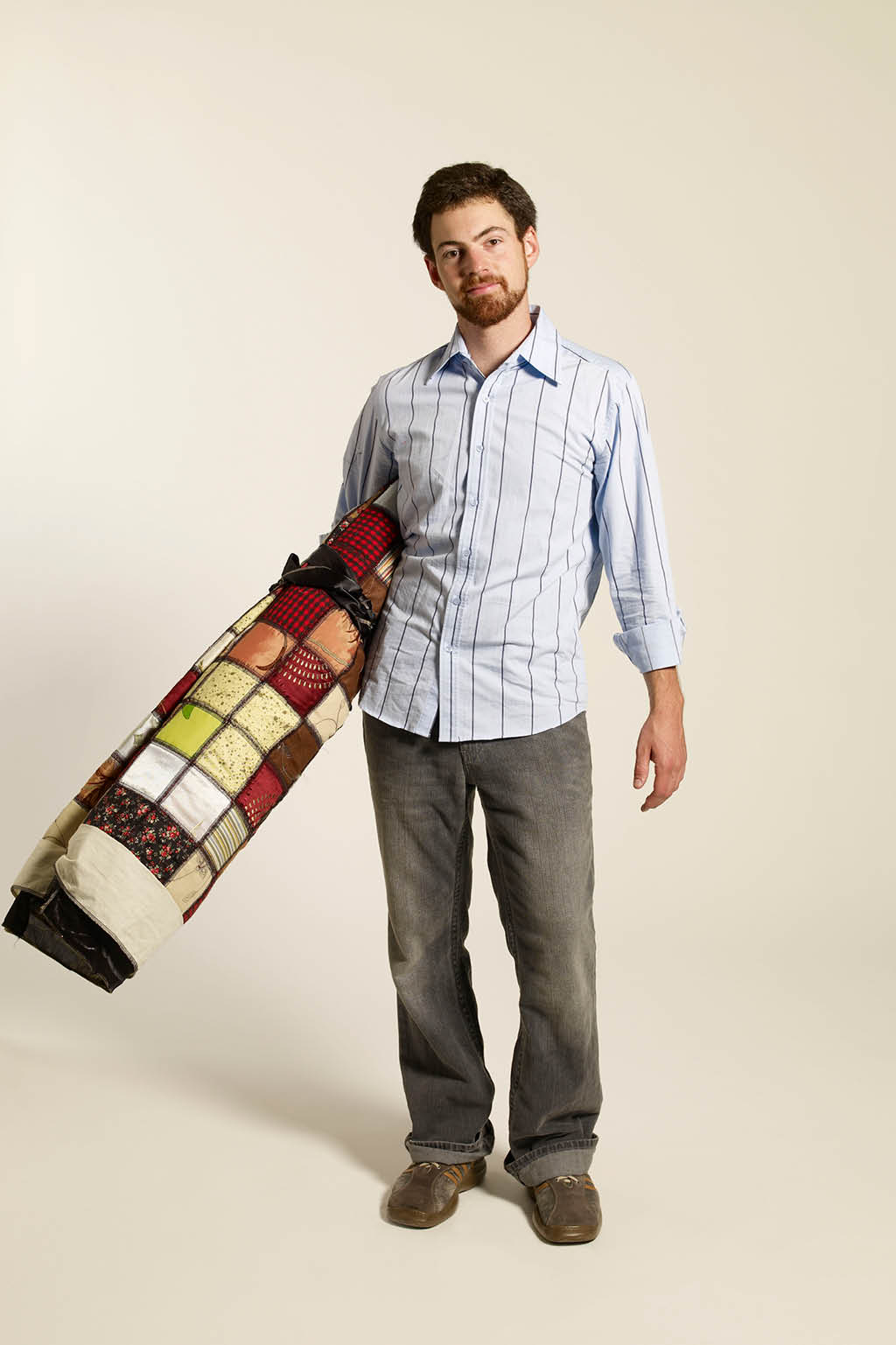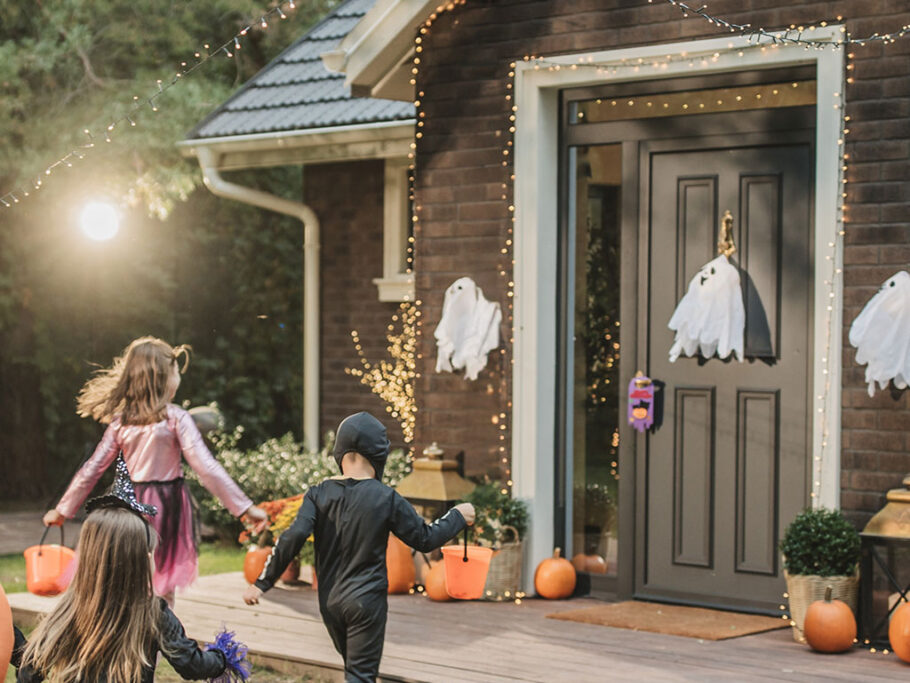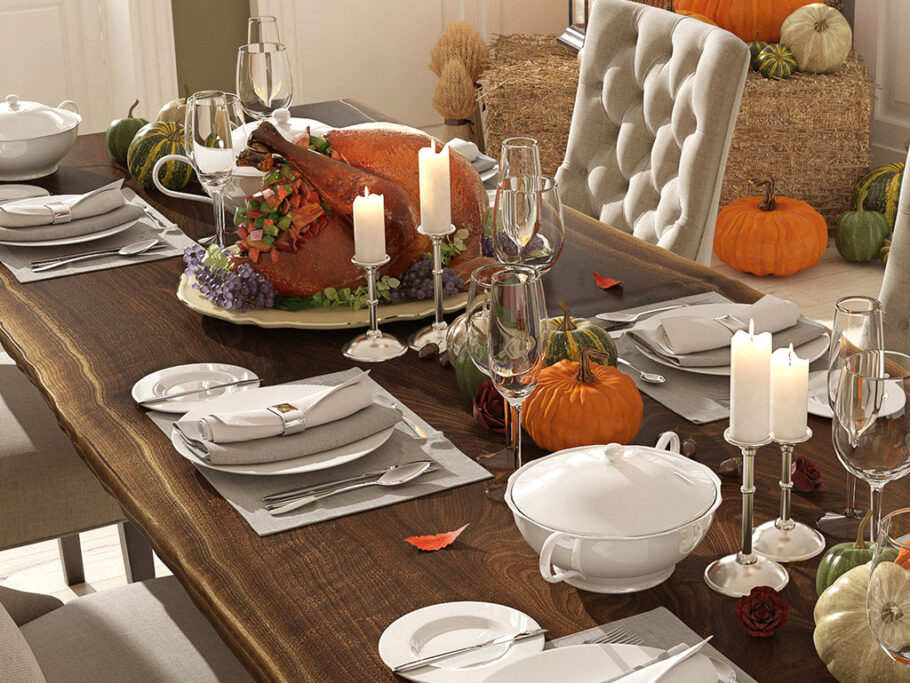Do You Know the Quilt Man?: An Interview with Luke Haynes
What was your childhood like?
My parents were young and divorced, so there was a lot of traveling between, as well as following them to the next adventure in their life—to schools or jobs often in a new state or at least a new city. I was a very curious youth, doing well in school and reading lots. I grew up with a collegiate peer group, and a lot of LEGOS® and bottle rockets. I was raised across the south, living in Texas, Virginia, Mississippi, Alabama, Tennessee, and North Carolina. I think having such an eclectic background has had a huge impact on my work, and has given me a greater sense of what it is to exist within a national context.
Do you come from an artistic family?
My immediate family is very creative. That fact was not so much emphasized as just implicit to the way we lived. Education was emphasized. We spent lots of time learning and questioning. The creation of art filled the time between learning, and kept my hands busy. My father is a per-forming artist, and my mother is a scientific artist—meaning that her creativity comes forth under the umbrella of chemistry and greater scientific pursuits—and my mother’s mother and grandmother are painters.
Describe a memory that you attribute toward your passion for art:
There have been many in my life. Before I even had any tools to create art, like the knowledge of drawing or painting and of course sewing, I had the desire to combine objects to fill space in an aesthetic manner. I remember at five years old having rocks lining the window sills of our entire home that I had broken with a sledge hammer because I thought the insides were pretty. And of course forts with the couch cushions and dining room chairs (to which I would attribute my later penchant for architecture).
When did you discover your talent? Was it something that you always wanted to do?
My art was more a part of my life than it was a pursuit. I had to create as part of my sanity. Like eating and breathing, it came as a necessity to fullfill my corporeal needs. I wouldn’t even go so far as saying talent, but more a product of practice and my interest in the creative process. I came at art and its creation from a logical constructionist standpoint rather than a heady conceptual one.
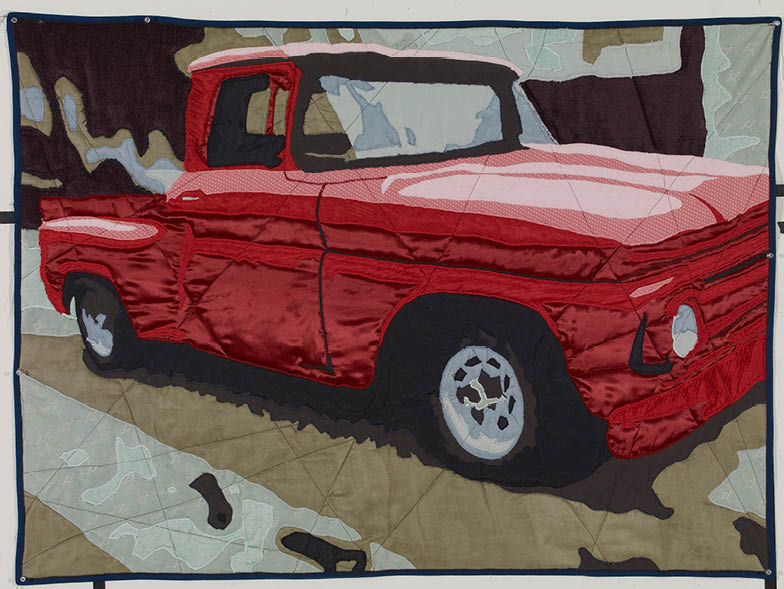
How did you get into using fabric for art? Why did you choose this medium?
It chose me. I had occasion to try my hand at lots of other methods of image creation and construction, and fabric fit most closely with my planar notions of flattening perception. Also the tactile manufacturing of taking parts and creating a whole makes sense to me more than taking pigments and alluding to a visual. Plus the medium has imbued within it such a rich history of pragmatism and function. I gravitate towards things that are rooted in utility. My years studying architecture have grown in me a deep appreciation for the form of function. Quilts are made for warmth. Quilts are made for survival. There is some-thing visceral about constructing a covering out of pieces of fabric, quilted together to hold in the batting which is the source of the insulating qualities of a quilt.
Are you professionally trained as an artist?
I spent some time at the North Carolina School for the Arts, in the visual arts conservatory, studying fine arts technique; however, the bulk of my training is in either carpentry or architecture. I spent summers and winters in school building houses and renovating buildings, which led to my pursuit of architecture. My penchant for the manual construction of spaces and the notions of affecting environment led to my years at Cooper Union in New York studying architecture. Within the program there, I had a few drawing classes and photography classes, as well as much input from professors on my presentation methods and visual clarity.
What other unusual mediums do you use?
I have made drawings out of broken glass. I have used plywood as the canvas for painting. I have drawn with fruit, but the most prevalent medium outside of the standard set of “fine art” processes I use is tape. I have done quite a few drawings in tape, architectural renderings on clear acetate that flip up to reveal the inside, and whole canvases made out of tape with pictorial images made from the colors of common tape (silver, black, and white).
What is your motivation for creating?
Creating is the single greatest motivator in my life. To me, it is as important as eating, breathing, or moving. Not in a hyper, intense, focused way, but rather in a way that is just a part of life, just part of the week. It is how we affect our world. It is a method of my communication. It is my way of leaving a legacy or responding to the legacy left behind by my predecessors. It’s communications without the boundaries of language.
Where do you find inspiration for your art?
The majority of my art has been a process-driven result. I set parameters for myself and make work from that. For this reason, I love commissions and themed shows. It allows me to be creative with a response to a query; it allows for work that is site or idea specific. There are no universal truths as well as there is no universal art, so I strive to make work that hangs in the space for which it was created. I admit that at times this makes for some final results that are not the easiest to access by the general viewing public, as they are images of people in my life or of objects responding to a particular set of restraints.
What artists have influenced you and why?
The list is long. I have been profoundly influenced by the work I have seen throughout my life. There are a few artists that come quickly to mind: Chuck Close, Claus Oldenburg, Piet Mondrian, James McNeill Whistler, Antoni Gaudi, Tadao Ando, and Shigeru Ban. Some were artists, some were architects, but all were aware of the essence of creating space and following their process to the end.
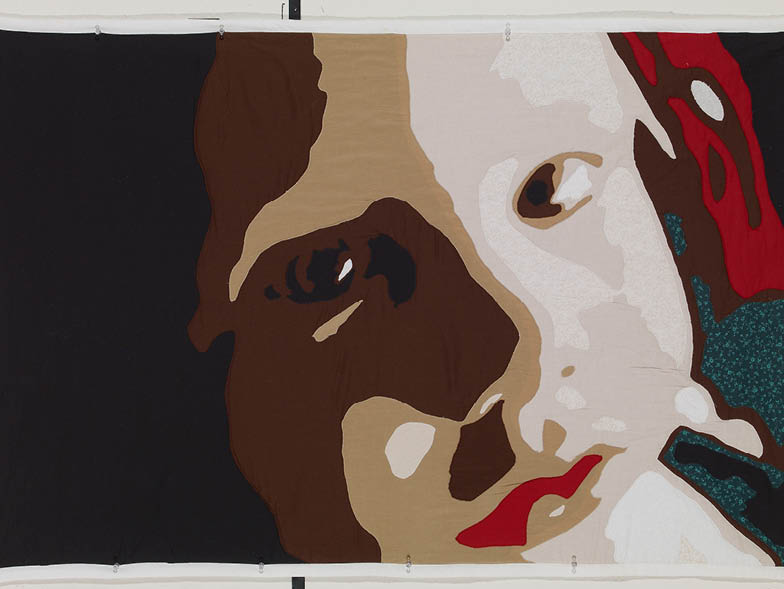
Describe the process of creating your quilt art:
I start with what I want it to look like finished; then I work out how to make that happen. I find that I tend to get larger and larger the more I work an image. My default is to create quilts that are in keeping with the actual size that a quilt would be to warm sleepers in the night. I have been experimenting with smaller sizes in the past few years for ease of hanging.
What is the atmosphere of your work space?
Most of my studio spaces over the past few years have been makeshift. I tend to have a very eclectic work environment. If I have a great idea, I will write it on a paper and pin that to the wall. The longer I am in a space, the more ideas accumulate on the wall, until the wall becomes a patchwork of thoughts. I like to keep a clean workspace for functional reasons, but as a project comes to fruition, I tend to have drifts of detritus in the corners of the room, and threads everywhere. I have to turn over my vacuum and cut out the threads every couple of months, or it gets too covered to turn. The studio is often in contrast to my living space which is designed to be utilitarian with clean lines and simple decorations.
Hours:
The time it takes for a project depends greatly on the project. The range is from about a week to a month, depending on the size. My work schedule is a bit varied depending on where I am living and what else I have to work on. When I work, it tends to be in long stretches. I will stay in the studio for ten to fifteen hours at a time. I think this work ethic comes from my training in architecture, where it is necessary to have those kinds of hours. I don’t have any kind of scheduled hours to work in a day or a week. The only schedule that I hold to is eating barbecue every Thursday.
What is the most fulfilling part about your work?
It is important for me to create. It is a component of my needs as a person, so it is great to get to work in a way that promotes my ability to create. I also love to design new ways to accomplish my goals. In quilting, I have a set of stitches and fabric options, but outside of that, there are millions of ways to vary those to make a project. The greatest moment comes when I can hold up a piece and see the idea that I had from the beginning looking back at me, and often the product comes out better than the idea. It’s quite rewarding to take an idea from conception through fruition inside a month. Plus I like to touch all the cool fabrics.
When is it not enjoyable to work on a piece of art?
There are always times in any job where it becomes rote or tedious, or the deadlines take the fun out of the process. At times, I get disinterested in a project near the end because I have it all done in my head, and all that is left is the busy work. Most of the time, I have a great time working with fabric and sewing, until the binding needs to go on. For some reason, I have a strong distaste for putting on the binding. Maybe because it is tedious or time consuming at the time when I want to be done and see what I have completed.
How do you overcome creative blocks?
I do something else. I try and work another way, or take a break and come back to it at a later time. Or sometimes I take myself out of the process of creating by making a project out of a set of parameters given from an external source, like an open call for a gallery with a theme, or from a series I am working on and have made a list of things to do at a time when the mojo is working. And always in my moments of dire struggle, I can look to the artists I want to emulate and get inspired by their work and methods.

Describe your style:
I quilt. I paint with fabric. I convey visual concepts through the planar manipulation of three-dimensional form represented with pieces of two-dimensional color. I combine Giacometti with Chuck Close and add some Appalachian methodology.
Your favorite subject:
I would have to admit—with a bit of chagrin—that it would be me. I like to create self portraits for several reasons: It seems to me a neutral subject and a very easy subject to get a hold of. I can work on my process and methods without having the stigma of content to be worried about. Also there is a lot of body issues and self referential media in our culture, so as an artist, it is interesting to create an icon of one’s self. Branding is everything. I get a lot of flak from peers and friends about working with self portraiture, because it seems to overlook the context in which I make my work. This critique seems to me a bit topical, and yet a challenge for me to contextualize myself in a world of visual communication.
What is the largest project you have created?
I created a backdrop for a play that traveled the world. The play was an immense success, written by a great friend of mine out of Strophium Productions. The quilt measured ten feet tall and fourteen feet wide, and has traveled the globe for a few years now as part of the show.
Talk about a moment within your career that you will never forget:
One of the greatest defining moments is the moment when I decided to move across the country with everything I own in a Honda Civic hatchback to live on a llama ranch and work in exchange for rent. This was the moment when I acquiesced to be an artist, when my pursuit of art was paramount over stability and comfortable complacency. And 3,000 miles later, I was making it happen by the sheer force of will (and a bit of hay). Within a month, that came crashing down around me, but it proved to be the catalyst that I needed to get out into the world and make myself known.
Is it different when you turn a hobby into a career?
It is different. It’s like making a girlfriend into a wife; the commitment makes the dialogue deeper and more present. The only loss is the feeling of newness, that desire to stop what you are doing in order to make more time for it. Since the hobby is now what you are doing, there is nothing that needs to be stopped to make time for its pursuit. We have only time, and if that is not filled with what you love, then it is squandered. I’m just so elated that I can support myself with my art and passions. Thanks to everyone that makes that possible.
What do you hope to accomplish through your work?
I want to make an impact on people, either through an exhibition, or a piece of functional art on their bed, or through a change in perception. I want to do my part in proliferating good design and conscious living.
How has your work been received by the public?
The public loves my work. It has such a nostalgia as well as tactile qualities that make it fun to look at. It’s a bit off the beaten path, so it’s a spectacle which people love to see. The response I got most of the time when I began putting my work out in galleries and into public spaces is that I was doing something so unusual that it was hard for them to place it within the context of fine art. They were all waiting for someone else to take a chance on me and see how I was received in the world of fine art. One of the early galleries that took that challenge was the Jan Larsen Gallery in N.Y.C. For that boost of confidence and support, I am ever grateful.
What quotes or mottos are you fond of that pertain to your work or life in general?
I often say my motto is: ‘nothing in moderation.’ I find that in order to make anything happen, it is necessary to commit to it. So go all out, get dirty, talk to everyone until someone says yes, and take the time to do what you do well.
If you weren’t an artist, what would you be doing?
I’m not sure you can divorce the two, but I would have to say that were I not an artist, I would work in the field of architecture. I think that is one of the great-est and most important fields of work of our time, as well as one of the fields most devoid of conscious thought. I continue to be intrigued and aware of the progress in that vocation.
What is life like outside of work?
Besides sewing and drawing, I like to dance and travel. I often travel for dancing. The dance I mostly do is a vernacular swing dance called the Lindy hop, born out of the Harlem renaissance. I am addicted to Lost and 30 Rock. I have lived in twelve states. I am a dog lover, but am too transient to be a dog owner, so I pet every dog I pass on the street. Architecture is a big part of my life; it has become more of a hobby for now.
For more info visit lukehaynes.com
